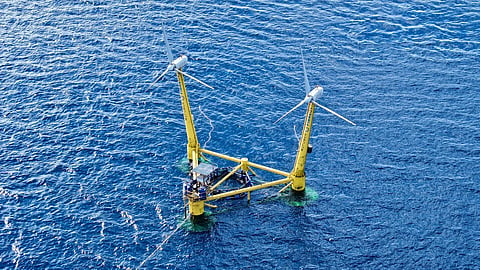

The system aims to demonstrate how renewable energy and aquaculture can operate together efficiently within shared maritime space - the first time such a system has been tested in the Atlantic.
Photo: AquaWind
The AquaWind project, a European initaitive developing a multi-use offshore platform integrating floating wind power and aquaculture, has reached a key milestone with the launch of the first offshore trials in the Atlantic to combine both activities in a single system.
On 18 October, the project’s prototype was towed and installed at the Oceanic Platform of the Canary Islands (PLOCAN) test site to begin full-scale sea trials. The operation was coordinated by Spanish engineering company EnerOcean after several months of preparation and harbour testing at the Astican ship repair yard in Las Palmas de Gran Canaria. The offshore operation involved the Port Authority of Las Palmas (Capitanía Marítima), towing company Boluda, logistics provider Miller, and maritime services firm Trames.
The AquaWind prototype combines EnerOcean’s W2Power twin-turbine floating wind platform with an aquaculture cage developed by researchers from the Canarian Agency for Research, Innovation and Information Society (ACIISI) and the University of Las Palmas de Gran Canaria (ULPGC).
The cage, which uses novel net materials and a digital remote-control system, will host biological trials with several fish species, including high-value ones that could help diversify aquaculture production, according to the researchers.
In a news release announcing the latest step in the project, the project team said the AquaWind system aims to demonstrate how renewable energy and offshore fish farming can operate together efficiently within shared maritime space - and represents the first time this has been tested in the Atlantic.
Researchers will monitor how the two activities interact and how they can be jointly managed using remote-control systems.
The AquaWind prototype and some members of the project team pictured at the ASTICAN shipyard, Las Palmas harbour, Gran Canaria, during the final testing phase before offshore deployment.
Photo: AquaWind
Before its offshore deployment, the prototype underwent extensive testing. The EnerOcean team, working with marine engineering firm INNOSEA, adapted and modelled the W2Power platform to integrate the aquaculture system. At the same time, the Portuguese research organisation WAVEC Offshore Renewables, supported by PLOCAN, ULPGC and aquaculture company CANEXMAR, carried out environmental baseline studies on sediment composition, water quality and underwater noise.
Meanwhile, at the Taliarte harbour site in Gran Canaria, researchers from ACIISI and ULPGC, assisted by CANEXMAR, tested the cage’s remote operation systems and carried out comparative trials with gilthead seabream (Sparus aurata). The results provided reference data on growth, survival, health and stress indicators, establishing baseline parameters for the forthcoming offshore phase, the researchers said.
Over the coming months, the AquaWind team will monitor fish growth, system performance and environmental impact under real-sea conditions. Following trials with gilthead seabream, tests will be extended to greater amberjack (Seriola dumerilii) to assess the platform’s suitability for other high-value species.
The data collected will inform future pre-commercial developments, digitalisation of operations and the design of scalable business models for integrated offshore energy and aquaculture, the research team announced.
AquaWind is co-funded by the European Union under Grant Agreement No. 101077600. The consortium includes the Canarian Agency for Research, Innovation and Information Society (ACIISI), the University of Las Palmas de Gran Canaria (ULPGC), EnerOcean, CANEXMAR, PLOCAN, consultancy Consulta Europa, the Canary Islands Maritime Cluster, WAVEC Offshore Renewables and INNOSEA.
